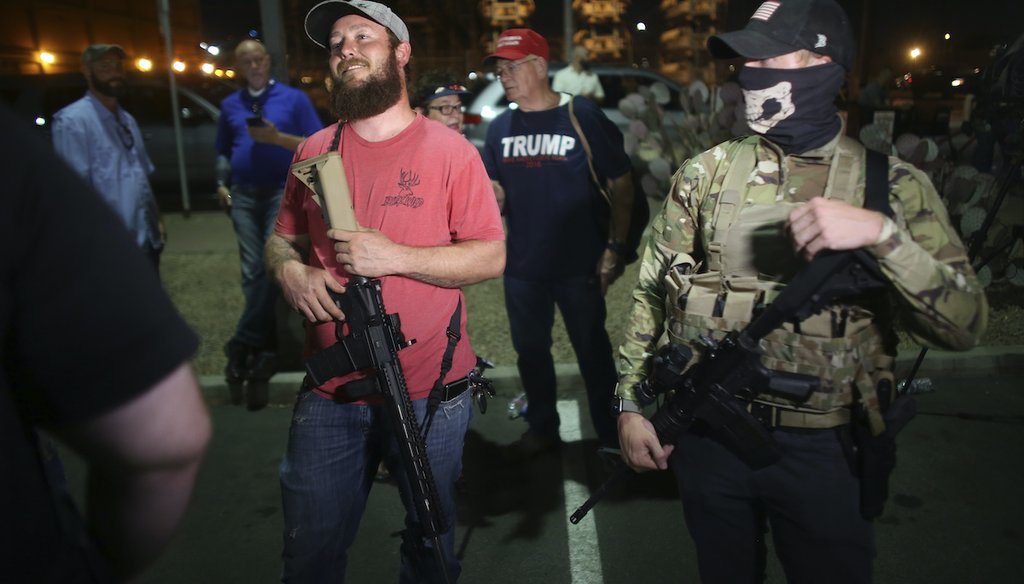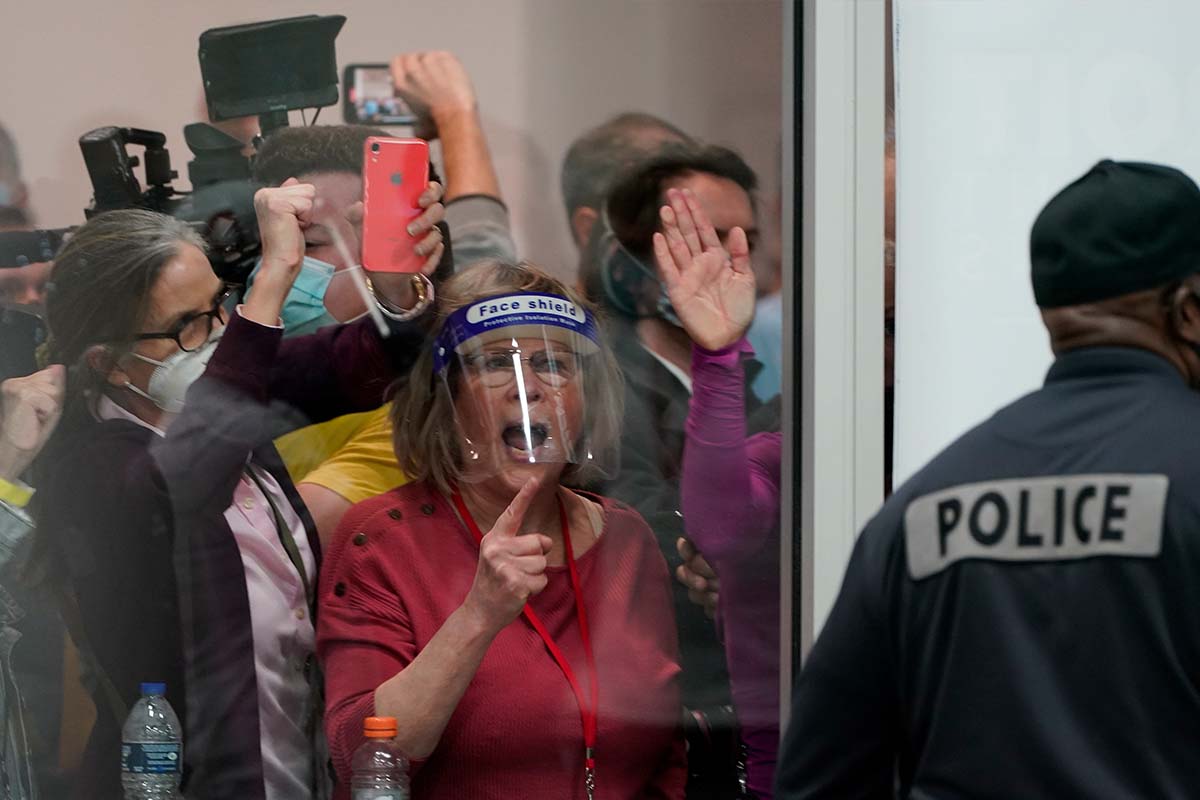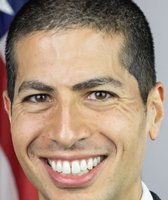Stand up for the facts!
Our only agenda is to publish the truth so you can be an informed participant in democracy.
We need your help.
I would like to contribute

Armed supporters of then-President Donald Trump stand outside of the Maricopa County Recorder's Office, where general election votes were being counted, Nov. 5, 2020 in Phoenix. (AP)
If Your Time is short
-
Many local election officials have taken steps to increase election security in response to threats and other incidents since 2020.
-
Steps include installing panic buttons, adding security cameras and creating plans with law enforcement officials about how to protect voters and election workers.
-
Many states prohibit guns at schools and other places that are frequently used as polling locations. But the majority of states do not explicitly ban guns at all election sites.
After the polls closed in November 2020, Americans witnessed an unprecedented intersection of violent threats and voting.
Men carrying rifles stood by with demonstrators outside vote tabulation sites in Arizona’s Maricopa County and Las Vegas. In Detroit, people banged on the windows of Detroit’s TCF Center. In Philadelphia, police arrested two armed men who had traveled from out of state outside the convention center.
Two months later, a violent mob stormed the U.S. Capitol in a failed attempt to prevent Congress from accepting results showing that Joe Biden won.
These incidents, along with death threats targeting election workers, have led local officials to increase their election security plans through Nov. 5 and, if necessary, beyond.
An overwhelming majority — 92% — of surveyed local election officials said they had taken steps to increase security for voters, election workers and election infrastructure.
Election officials say they are taking the threats seriously. But this fact is also true: Millions of Americans will cast a ballot without incident.
"Voting in America is safe and working at a vote counting center is also safe," said Seth Bluestein, a Republican city commissioner in Philadelphia who was working in a different city role at the convention center in 2020 as were counted. "In Philadelphia and jurisdictions across the county, election officials have taken a lot of lessons learned in 2020, and increased the security of ballot counting facilities."
Federal law enforcement officials are on watch. The FBI and Homeland Security Department told election officials that domestic violent extremists could "promote narratives about the election process," which would motivate them to act violently, CNN reported in October. The bulletin cited the two assassination attempts against former President Donald Trump.
The federal government had warned earlier that absentee ballot drop boxes could be targeted with "incendiary and explosive materials," according to Wired. Drop boxes, long used in some states to accept mail-in ballots, were not controversial until Trump raised fears about their security in 2020.
PolitiFact interviewed current and former election officials about what they have done to mitigate violence and protect their staff and voters. Officials said they have taken extraordinary measures to prepare but remain on high alert.
Shatterproof glass, panic buttons and armed security: Preparing poll sites
Election challengers look through the windows of the central counting board Nov. 4, 2020, in Detroit. (AP)
Urban battleground election offices are not the only places that have increased security.
More than 9,000 local jurisdictions administer elections nationwide, ranging from small townships to cities with more than 1 million voters. The 2024 Brennan Center for Justice survey found that 40% of respondents had enhanced physical security of election offices or polling places since 2020.
Voters may notice certain security precautions when they cast their ballot, whether that’s a security camera by a mail ballot drop box or police officers at an election office. Many state laws say that police can be summoned if needed, while a handful of laws say they can be regularly stationed at voting sites, and other states are silent.
"To some people a uniformed officer represents safety, to others it represents a bad history of voter suppression at some point in time," said Justin Smith, a retired sheriff from Larimer County, Colorado.
Kathy Boockvar, secretary of the Commonwealth of Pennsylvania during the 2020 election, said more jurisdictions nationwide have added panic buttons to contact law enforcement since 2020. Boockvar is a member of the Committee for Safe and Secure Elections, a group that trains election office workers.
Other steps taken by election offices include adding materials on windows to make them shatterproof and hiring armed security at vote counting sites. Some offices have also added tighter identification requirements before entering a vote tabulation center.
Josh Zygielbaum, the county clerk in Adams County, Colorado, and a Marine veteran, told PolitiFact in 2022 that he has a bulletproof vest. He said his office received threats in 2020, including a person "who said that they will see us on the battlefield and they will walk away alive."
More than one-third of local election officials in the Brennan survey reported that at some point during their job duties they had experienced threats, harassment or abuse.
A Justice Department task force formed in 2021 to investigate election threats has prosecuted 18 people as of mid-October. Election officials say that’s a small slice of the offenders.
Intensive planning, evacuation routes
Many precautions that state and local election officials take are invisible to voters. That includes meeting with law enforcement in the months leading up to Election Day, running disaster drills and writing plans showing how they will operate in an emergency.
The Committee for Safe and Secure Elections teaches election offices how to improve their security plans and deal with disruptive visitors. Smith, one of the group’s trainers, said he encourages election officials to think about how they would handle upset voters and keep them from interfering with employees and ballot deliveries.
"It doesn’t mean you have a wall of police officers outside, it means you have a plan," Smith said. "You look at how your office is set up."
Smith said that the 1999 Columbine school shooting was a wake-up call for schools and law enforcement to talk to each other. The threat of violence surrounding elections in 2020 was similarly a wake-up call for election workers and law enforcement.
Pierce County, Washington, was one of multiple election offices spanning a handful of states that received a letter with white powder in November 2023. The letter contained a typed threat: "end elections now."
Linda Farmer, the county auditor, said the county will now have multiple law enforcement officers at the center where votes are counted. Because of voting-by-mail’s popularity in Washington state, the county also has extra hands to help secure ballot drop boxes and monitor traffic around the most frequently used drop box.
County officials are ready for trouble at election sites.
"We know how long it will take to clear if we have a bomb threat that turns out not to be real," Farmer said. "We know where we have to go if we have to shut down."
Counting the vote in 2024: Tighter security, faster results
Only voters and election workers are generally allowed inside the rooms where voting happens. But when polls close, the work shifts to counting ballots, which sometimes means a change in location.
Most states have laws that define the roles of observers and how many can be present. Political parties and campaigns appoint poll watchers who can observe voting and ask questions of election staff if they have concerns.
After the polls close in Minnesota, "the law is less clear about access," Secretary of State Steve Simon said. "Our legal advice to counties has been to let people in who want to watch consistent with everyday common sense policies. We aren't going to let a swarm of 50 people for all sorts of reasons, such as fire code, in every government building."
In Detroit in 2022, officials moved the vote counting site from the TCF Center — where people banged on the windows in 2020 — to Huntington Place Convention Center. Officials reported no chaos in the midterm election. The site had metal detectors and a weapons ban, the Detroit Free Press reported, and poll challengers had to undergo training and wear credentials.
Some laws have changed to quicken vote-counting following the tide of 2020 misinformation that fueled frustration among people waiting for results. Michigan law, for example, now allows cities with a population of at least 5,000 to start processing absentee ballots eight days before Election Day.
The Maricopa County Tabulation and Election Center has built additional 10-foot high fencing and added more security cameras since 2020. When temporary staff and ballots are in the building, the center will have more police officers.
Election offices have used federal money from the Help America Vote Act, as well as state or local money to pay for security improvements.
Ben Hovland, chair of the Election Assistance Commission, said the Help America Vote Act has provided about $1 billion in security grants since 2018. But when you take into account that it can cost one state $100 million to replace voting machines, the money doesn’t stretch very far.
The grants are a critical piece of the election security puzzle, but election officials say they need more funding.
"Elections are harder than they’ve ever been to run and they are expensive," Hovland said.
More than 1,000 election offices nationwide since 2023 have had physical security assessments by the U.S. Cybersecurity and Infrastructure Security Agency. Local officials can take those recommendations to the boards that fund their offices.
Only some states ban guns at polls, vote counting centers
Polling places are supposed to preserve what the Supreme Court has called an "island of calm" for voters.
All states ban "electioneering" at polling sites, which generally means that people can’t carry campaign signs inside a voting site.
But laws that expressly ban guns at voting sites are far less common.
Following the 2020 election, more states have adopted laws restricting guns near election sites, but many still allow guns at certain election facilities. In Nevada, the Democratic-led Assembly passed a ban on guns near voting sites, but Republican Gov. Joe Lombardo vetoed it over constitutional concerns.
Many states prohibit guns at schools and certain other places that are frequently used as polling locations. But the majority of states do not explicitly ban guns at all election sites. States have a smattering of laws — some of which ban open or concealed carry, or both — and only some ban guns at vote counting centers.
The U.S. Supreme Court has been clear that states can prohibit guns at election sites, the Brennan Center found. Several states with high rates of gun ownership, such as Arizona, Florida, Georgia, Louisiana and Texas, have long prohibited firearms where people vote.
The Georgia Supreme Court wrote in 1874: "The practice of carrying arms at courts, elections and places of worship, etc., is a thing so improper in itself, so shocking to all sense of propriety, so wholly useless and full of evil, that it would be strange if the framers of the constitution have used words broad enough to give it a constitutional guarantee."
The Global Project Against Hate and Extremism found in a 2022 survey that restricting guns at the polls has widespread support, including among gun owners. Nearly 80% of Democrats supported a ban, as did more than 50% of Republicans and Independents.
A September University of Chicago/NORC survey, however, found "disturbingly high levels of support for political violence" and it was bipartisan, said Robert A. Pape, a political science professor at the University of Chicago, where he directs the Chicago Project on Security and Threats.
Nearly 6% of respondents agreed or strongly agreed that the "use of force is justified" to restore Trump to the presidency. A little more than 8% agreed or strongly agreed that force was justified to prevent Trump from becoming president.
Although election officials have concerns about security, they told us that they believe they are confident that voters can safely cast a ballot.
Boockvar called on politicians to do their part to secure elections.
"What we really need to have happen more than anything else is every political party, every candidate running for office, everyone currently in office needs to lower the temperature and tell their people whether our candidate wins or loses our elections are won fairly and securely and the results audited, and if necessary recounted, and are observed in public by bipartisan officials."
RELATED: Can social media platform outages impact U.S. elections? Not likely, experts say
RELATED: The Republican Party wants more poll watchers. Here’s what they can, and can’t, do.
Our Sources
U.S. Cybersecurity and Infrastructure Security Agency, Security advisors, 2024
U.S. Department of Justice, Attorney General Merrick B. Garland Delivers Remarks at the Convening of the Election Threats Task Force, Sept. 4 2024
U.S. Department of Justice, Election Threats, Oct. 16, 2024
U.S. Election Assistance Commission, Continuity of Operations Plans, 2023
U.S. Election Assistance Commission, HAVA grants guidance on security spending, June 2024
U.S. Election Assistance Commission, HAVA grants guidance related to AI, March 2024
The Committee for Safe and Secure Elections, Four steps to working with challenging visitors and disruptive content creators, September 2024
Chicago Project on Security and Threats Omnibus Survey, Understanding Support for Political Violence in America, September 2024
New York Times guest essay by University of Chicago Professor Robert A. Pape , I Study Political Violence. I’m Worried About the Election. Oct. 10, 2024
Brennan Center, Poll of Election Officials Finds Concerns About Safety, Political Interference, May 1, 2024
Brennan Center, Protecting Voters and Election Workers from Armed Intimidation, Aug. 26. 2024
Campaign Legal Center, Electing the President: From Election Day to the Joint Session, Sept. 18, 2024
National Conference of State Legislatures, Polling places, Sept. 9, 2024
National Conference of State Legislatures, Policies for election observers, Oct. 9, 2024
The Washington Post, Feds increase security for Jan. 6 in effort to prevent Capitol attack repeat, Sept. 11, 2024
Nevada Independent, Lombardo vetoes three Democrat-backed gun control bills, May 17, 2023
CBS, Pennsylvania election officials are bracing for conspiracy theories, protests, Oct. 13, 2024
Detroit Free Press, Absentee ballot counting at Huntington Place lacks drama of 2020 election, Nov. 8, 2022
Axios, America's new election shields: panic buttons, bulletproof glass, Sept. 20, 2024
CNN, Election officials beef up security as new survey shows nearly 4 in 10 grapple with threats and harassment, May 1, 2024
CNN, Domestic extremists with ‘election-related grievances’ could turn to violence in final weeks of election, FBI and DHS warn, Oct. 3, 2024
Wired, DHS Warns Law Enforcement Election Deniers May Attempt to Bomb Drop Boxes, Oct. 17, 2024
The Associated Press, Election officials prepare for threats with panic buttons, bulletproof glass, Sept. 17, 2024
PolitiFact, Ballot drop boxes have long been used without controversy. Then Trump got involved, Oct. 16, 2020
PolitiFact, Dispelling a common myth about fentanyl as election workers get letters with traces of the substance, Nov. 10, 2023
PolitiFact, Most states don’t explicitly ban guns at polls. Some lawmakers want to change that, March 31, 2022
Telephone interview, Seth Bluestein, Philadelphia city commissioner, Oct. 16, 2024
Telephone interview, Linda Farmer, Pierce County, Washington auditor. Oct. 16, 2024
Telephone, Justin Smith, retired sheriff from Colorado and trainer for the Committee for Safe and Secure Elections, Oct. 16, 2024
Telephone interview, Kathryn Boockvar, former secretary of the Commonwealth of Pennsylvania and member of the Committee for Safe and Secure Elections, Oct. 17, 2024
Email interview, Marcus Thompson, spokesperson for Wake County, North Carolina, Oct. 17, 2024
Telephone interview, Matt Friedman, Detroit Votes, Oct. 17, 2024
Email interview, Melissa Howard, spokesperson for the city of Milwaukee, Oct. 16, 2024
FBI, Statement to PolitiFact, Oct. 17, 2024
Department of Homeland Security, Statement to PolitiFact, Oct. 18, 2024
Email interview, Cait Conley, senior advisor at CISA, Oct. 16, 2024
Telephone interview, Minnesota Secretary of State Steve Simon, Oct. 16, 2024
Email interview, Jennifer Liewer, Maricopa County Deputy Elections Director, Oct. 18, 2024
Telephone interview, Ben Hovland, chair of the Election Assistance Commission, Oct. 18, 2024
Email interview, Sandra Jauregui, Nevada State Assembly, District 41, Oct. 21, 2024

















































